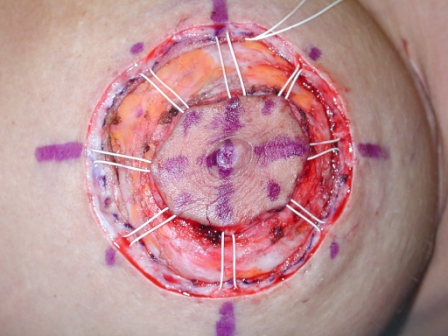McCormick Place, Lakeside Center
Sunday, September 25, 2005
9:00 AM - 5:00 PM
McCormick Place, Lakeside Center
Monday, September 26, 2005
9:00 AM - 5:00 PM
McCormick Place, Lakeside Center
Tuesday, September 27, 2005
9:00 AM - 5:00 PM
McCormick Place, Lakeside Center
Wednesday, September 28, 2005
9:00 AM - 5:00 PM
8513
The Interlocking Gore-Tex Suture for Control of Areolar Diameter and Shape
Purpose: The purpose of this paper is to describe a modified purse-string suture technique designed to eliminate the common complication of periareolar surgery related to postoperative spreading of the areola with shape distortion.
Materials and Methods: 25 patients underwent periareolar surgery to manage a host of nipple and areola complex malposition problems. These included cases of areolar spreading after augmentation mastopexy, primary augmentation mastopexy, tuberous breast, primary breast ptosis, and cases of a malpositioned nipple and areola after reconstruction. Using a CV-3 Gore-Tex suture on a straight needle, a periareolar purse-string was applied which passed through the dermis of the outer periareolar incision and, at equally spaced intervals, passed back through the dermis of the areola creating a pinwheel pattern (Figure 1). By locking these two dermal segments together, a stronger structural support for the periareolar closure was created. The unique nature of the Gore-Tex suture allows the nipple and areola complex to be easily closed down to the desired diameter due to the smooth and easy manner in which the suture passes through the dermal structural framework without bunching or gathering. As well, due to the nonabsorbability of the material, long term support of the wound is provided.
Results: 25 patients have been treated with a maximal follow-up of 8 months. In all instances, significant reduction of the areolar diameter has been achieved initially and maintained over time. This result has been most dramatically demonstrated in revisionary cases of periareolar augmentation mastopexy complicated by markedly widened areolar diameters. Even in cases of implant exchange for larger devices, reduced areolar diameters have been created and maintained over time.
Conclusions: By locking the outer periareolar incision to the inner areolar incision, a stable areolar size and shape are created which is resistant to change over time. The unique nature of the Gore-Tex suture allows the areolar diameter to be easily controlled as the suture slides without friction through the dermal framework. This technique is recommended as a consistent and versatile method to manage a wide variety of nipple and areola complex size, shape, and malposition problems.

